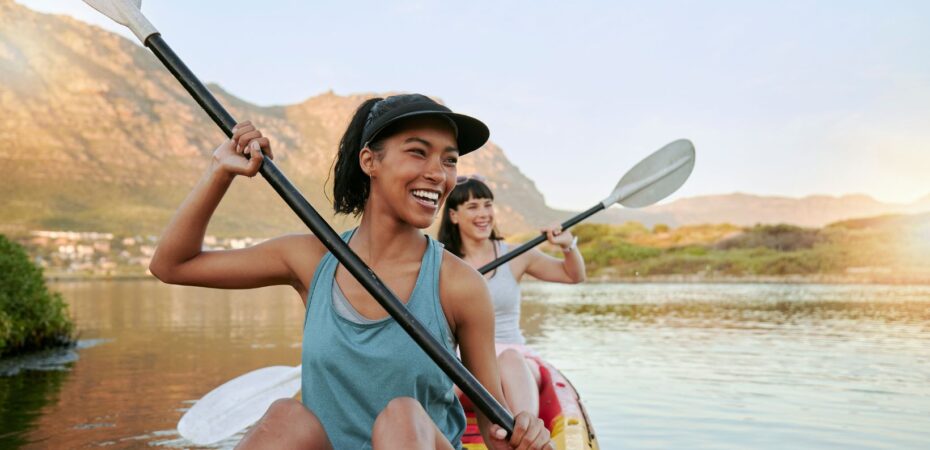The morning sun catches the ripples as you glide across that glassy lake. A two-person kayak transforms those peaceful moments into shared adventures. Nothing beats the quiet laughter, matched paddle strokes, and stories that unfold on the water.
A kayak for two people opens up a world of hidden coves and tranquil rivers. When you’re out on the water with someone you care about, the experience feels richer.
Ever wondered what’s around the next bend? Here’s how to get started on kayaking.
Choosing the Right Location
Start by scouting local water bodies. Lakes are ideal for beginners, while rivers with gentle currents suit intermediate paddlers. Save coastal areas for calm days, especially when you’re new to kayaking. Avoid open coastlines or areas with strong currents.
If you’re eyeing to use a 2 person inflatable kayak in Australia, focus on protected waterways like Sydney Harbour’s coves or the tranquil Gippsland Lakes. These spots minimize sharp rocks and rough waves that could challenge inflatable models. Apps like Go Paddling help you find launch points with parking and restrooms for added convenience.
Always check if permits are needed. Some nature reserves require fees or have seasonal restrictions. For example, a protected estuary might ban kayaking during bird nesting season. Here’s a pro tip: Call local outfitters. They’ll share hidden gems and warn you about algae blooms or tricky currents.
Planning Your Route
A safe and fun two-person kayak adventure thrives on good planning. Aim for a two to four-hour route if it’s your first time doing this activity. Paddling against wind or current doubles effort, so factor that in. Use Google Earth to spot picnic-friendly beaches or sandbars. Loop routes are fantastic tools.

They let you start and end at the same spot without shuttle hassles.
Check the weather forecast the night before your paddling trips. If winds hit 15+ mph, there’s no harm in rescheduling. Fighting gusts in a tandem kayak feels like paddling through molasses, and it’s also potentially unsafe.
Gathering Necessary Equipment
Like other types of watercraft, not all kayaks are designed the same way. Your two-person kayak should match the water type. Recreational kayaks (wide, stable) work for lakes, while touring models (narrow, faster) suit rivers. Inflatable kayaks are good for deep, calm waters, while plastic vessels like kayaks from Flow Kayaks are best for rough, choppy or rocky waterways.
Kayaking can sometimes take you far from the closest establishments, like restaurants or hotels. So, pack a dry bag with a first-aid kit, energy bars, and a fully charged phone in a waterproof case. Throw in a bilge pump and sponge; even stable tandem kayaks can take on splashy water. Don’t forget a kit containing some emergency tools, like duct tape, zip ties, and a multi-tool for quick fixes.
Safety Precautions
Water-related activities require extra protection through life jackets. Remember to test-fit them to know if they aren’t too loose or too tight. They shouldn’t ride up when you raise your arms. Life jackets should also be worn at all times while in the vessel. Even strong swimmers can be stunned by cold water.
Participating in outdoor adventures often makes communication difficult. Strong winds and crashing waves could muffle your words. Agree on commands before launching to communicate with your kayaking partner more easily. Consider using the word ‘hut’ to switch paddle sides or tapping your head to signal a break.

Practice techniques to survive capsizing in shallow water: Slide out, flip the kayak, and climb back in. If you’re exploring tidal areas, note the tide schedule. Getting stranded on a mudflat isn’t fun. Lastly, share your float plan with someone else you trust, not just your kayaking partner. Someone on land should know where you’re going and when you’ll return.
Enhancing the Experience
How about turning your two-person kayak into a floating picnic spot? Frozen grapes make a refreshing snack, and sandwiches wrapped in reusable beeswax wraps are easy to pack. If you’re into inshore fishing, a compact rod clipped to the deck can come in handy. Bass tend to hang out near fallen trees, so keep an eye out. It’s all about blending relaxation with a bit of adventure.
For photos, prop your phone on a mini tripod wedged between the footrests. Are you spotting wildlife? Paddle together silently near shorelines at dawn; herons and otters are early risers. End the day by jotting down highlights in a waterproof notebook. The little moments—like spotting a turtle sunbathing—stick with you.
Final Thoughts
Planning a two-person kayak trip mixes preparation with spontaneity. Choose your location wisely, pack smart, and stay adaptable.
As with any sort of outdoor activity, it’s not about perfection. Maybe you’ll zigzag at first or splash each other, giggling over a messed-up paddle rhythm. That’s the magic and fun of kayaking. After your adventure, share your story by posting a photo, joining a kayaking forum, or just reminiscing over coffee.
Ready to make waves? Grab a paddle and a partner, and let the water lead the way.


 By
By 




